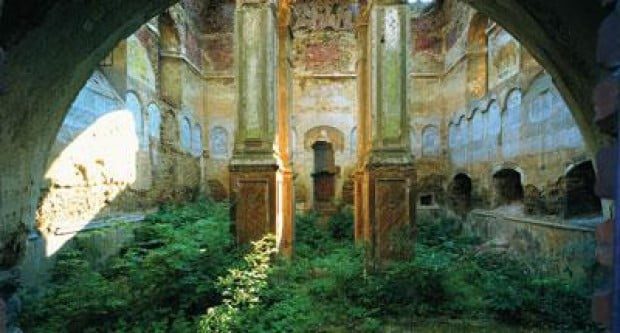
The most impacting portion to the Payson Library exhibit is dedicated to Holocaust sites of massacre and destruction. Upcoming events and speakers tied to the exhibit take place the end throughout February.
By Paul Sisolak / Special to The Malibu Times
“Traces of Memory: A Contemporary Look at the Jewish Past in Poland,” opened last week in Pepperdine University’s Payson Library. The exhibit, the first of its kind displayed in the campus library, portrays recent images of Polish Galicia in Eastern Europe, as photographed by Chris Schwarz, a late British photojournalist.
At once stark, historical, current and contextual, the objective behind the exhibit was to examine the reclaiming of Poland’s Jewish past and heritage, said Jonathan Webber, an Oxford University professor whose book “Rediscovering Traces of Memory” documents the journeys across Eastern Europe that he and Schwarz embarked upon during the course of a dozen years.
“The idea of this exhibition was to cover a number of emotions and feelings. You just can’t stereotype Poland and say, ‘It’s all in ruins, or it’s all gas chambers,’” Webber said during a phone interview from England last week. “You have to look at that they have gone back to these places and have tried to restore what was before.”
Webber and Schwarz, who died four years ago, undertook the assignment in 1993. The results portray a Poland deteriorated, though sometimes unchanged, since the devastations of World War II.
The former Poland is detailed in a section devoted to Jewish life in ruins-an abandoned synagogue in Krakow, the crumbling remains of holy markers and cemeteries. Schwarz had also found places almost frozen in time, from a traditional Jewish urban courtyard to the inscriptions written in Hebrew, preserved remarkably well.
“We decided to photograph all the monuments in Southern Poland we knew about,” Webber said. “There was no guide book in the world at all on that. It was virgin territory.”
But the most impacting portion to the Payson Library exhibit is what Webber dedicates to Holocaust sites of massacre and destruction. The Nazis killed seven thousand Jews in June 1942 near the town of Tarnow; Webber and Schwarz found a mass grave with 800 of the dead. In another photo, a mass grave marker bears the number “364” – the entire village of Rzepiennik Strzyzewski, taken into the forest by German soldiers and shot.
Several pictures also spend time inside and around the former Auschwitz prison camp; one bears the darkened interior of a gas chamber. For its caption, Webber chose to quote Holocaust historian Rafael Scharf’s recounting of a Jewish mother and child’s conversation before their execution in the chamber: “‘Mummy, when they kill us, will it hurt?’
‘No, my dearest, it will not hurt. It will only take a minute.’
It only took a minute-but it is enough to keep us awake till the end of time.”
Louise Steinman, curator of the Los Angeles Public Library, was a guest speaker at the Feb. 1 event. She also visited Poland to trace her family’s Jewish history, which Steinman will recount in her book, “The Crooked Mirror: My Conversation with Poland.”
Steinman spoke of her visit to Radomsko, of which 18,000 Jewish residents were slaughtered in the Holocaust.
“Each time I visit Radomsko, I find new traces of my family, and the life and culture there,” she said. “The Jews were a part of Poland’s body and soul.”
Don Singer, a rabbi from Pacific Palisades, was one of several visitors to the library gallery moved by the exhibit. “It touches my heart,” he said.
Webber said his compilation of Schwarz’s photographs asks an important question: How do the Jews of Poland deal with their past?
“In some cases, they’ve ignored the Jewish issue,” he said. “In many cases, they did restore things and put up monuments.”
Webber was keen to include photos of that reclamation. The March of the Living Parade near the Auschwitz camp, and the Krakow Jewish Culture festival are a testament to that.
Ken LaZebnik, Pepperdine’s director for Library Advancement and Public Affairs, said the collection is on loan from the Galicia Jewish Museum, and was proposed as an exhibit in Malibu by the Diane and Guilford Glazer Institute for Jewish Studies.
Rebecca Golbert, a visiting Jewish Studies professor at Pepperdine, said part of the institute’s drive is to develop a Jewish studies curriculum at the school, with hopes of making the program a minor.
Other events tied to the exhibit will take place through the end of February. On Feb. 10, PEN-award winning author Jerome Rothenberg will give a reading of his poem “Poland/1931,” and on Feb. 23 and 24, Kate Fuglei will perform “Rachel Calof,” a one-woman show based on the real-life story of an 1890s Jewish pioneer to North Dakota, adapted from the memoir by LaZebnik.
On Feb. 20, Webber will appear to speak about “Traces of Memory,” and the attitudes represented in the gallery.
“Some people remain quiet; others become concerned citizens. Other things fall into ruins; others get restored,” he said. “You can’t predict how people will react in a post-genocide situation. No two human beings are the same. That’s what’s so interesting, to try and understand this as an example that human beings are all different from each other.”
More information about the exhibit can be found online at www.library.pepperdine.edu/events/traces.htm
